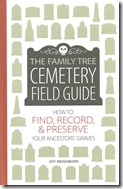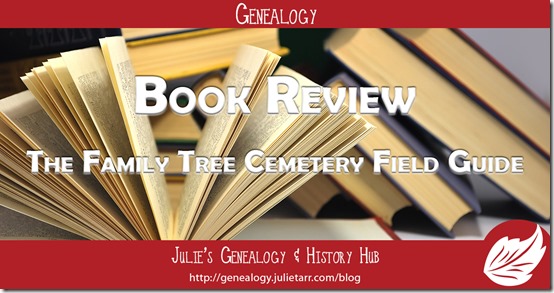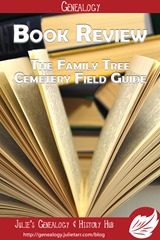 Title: The Family Tree Cemetery Field Guide
Title: The Family Tree Cemetery Field Guide
Author: Joy Neighbors
Format: Hardcover, Kindle
Published: 2017
My Rating: ![]()
![]()
![]()
The following review first appeared in the Federation of Genealogical Societies FORUM magazine (Fall 2018); reprinted with permission.
Cemeteries are one of many resources genealogists should consult as they investigate their ancestors. The Family Tree Cemetery Field Guide was written to help genealogists discover just what a cemetery has to offer.
The book is organized into four parts. The first part relates to planning a cemetery trip. In chapter 1, readers will find a brief history and the evolution of cemeteries, including an introduction to the types of cemeteries that exist. Chapter 2 is helpful because it introduces the reader to the various records, beyond gravestones, that could be found in cemeteries to further assist with genealogy research. These records include interment records, burial permits, plot records, plat maps, and deeds.
The first part finishes up with chapter 3, “Finding Your Ancestors’ Graves.” The main focus of this chapter is using websites such as BillionGraves and Find a Grave to locate a grave. The author also suggests checking to see if the cemetery has a website that has a database of burials. What the author neglects is traditional or other sources used to find cemetery information, which genealogists often have in their possession already from prior research. Death certificates, church burial records, and obituaries and death notices are some of the first records sought in genealogy research and oftentimes answer the question of where an ancestor is buried. Why jump to a website’s database of a gazillion records across the globe and have to weed through hundreds of results, or, alternatively, come up with nothing? Another source neglected is cemetery books compiled by local societies. Even if the cemetery is not known, a quick glance in books for different county cemeteries could prove useful, and oftentimes these books contain the plot information, making the cemetery trip even easier. One strategy neglected is simply calling the cemetery office to check on a burial and gather plot information. Granted, this strategy doesn’t work with defunct or neglected grounds, but it is an option available to researchers. There’s nothing wrong with heading to these and other websites, but researchers could save time by looking at what they have first and then, once they have a focused place to look, head over to those websites to see what else can be gleaned.
Part 2 is all about conducting cemetery research in the field. Chapter 4 has great tips for planning the trip, including a checklist of items to pack and what to do upon arrival. There is a great section called “Twenty-one Nuggets of Information,” where the author lists all the things you might come across during your trip. While it’s somewhat repetitive of the information provided in chapter 2, it is nice to have the list in one place. However, it is a bit misleading since it implies that one can find these “twenty-one facts” in the cemetery. While researchers perusing the cemetery grounds will certainly want to keep their eyes peeled for information such as plot owner, burial cost, copy of death certificate, and type of grave, if the cemetery is no longer operational and doesn’t have an office, these answers cannot be found with a trip to the cemetery. Excellent tips for photography, especially large stones and family plots, round out the chapter.
Chapter 5 contains additional tips for photographing stones, particularly those that are hard to read. There are also tips for reading old handwriting. An interesting discussion on the causes of weathering, stone materials, and type/style of stones is also included.
Symbolism is an important part of deciphering gravestones, and chapter 6 covers, by category, the most common symbols and their meaning. There are two very useful charts at the end of the chapter: one with symbols and their meanings, another with a list of common abbreviations and their meanings (e.g., GAR stands for Grand Army of the Republic).
The third part, “Making Sense of Your Research,” is made up of two chapters. The first, chapter 7, covers things to do after the cemetery trip, including analyzing the findings, correlating findings with previous research, and identifying new research questions based on findings. There is also a short section with tips for enhancing the digital photos taken at the cemetery. The chapter closes with two case studies showing how cemetery finds can contribute to overall genealogy research.
Chapter 8 discusses how to share findings online, which, in this reviewer’s opinion, really doesn’t fit in part 3. There are four websites discussed: BillionGraves, Find a Grave, USGenWeb, and FamilySearch. There is some good information here to get researchers started, but keep in mind there are more to these sites than discussed.
Part 4 closes out the book with two final chapters. Chapter 9 discusses other records useful for genealogy research. The first section deals with various types of death records including death certificates, probate, obituaries, funeral home records, and coroner’s records. The remainder of the chapter talks about non-death records, such as city directories, land records, court records, and institutional records—all relevant to genealogy research, but not relevant for a cemetery field guide.
The closing chapter contains a short discussion on cemetery preservation. A list of organizations to contact for additional information is provided.
There are two appendixes. The first contains worksheets that are useful for genealogy research. The other is a great list of additional resources to consult. A subject index is also included.
Overall, there is some good information presented in this book. However, there was a lot of repetitiveness (i.e., same phrases and ideas repeated multiple times), which was distracting. In addition to repetitions already mention, another includes the nearly identical lists “Cemetery Research Kit Checklist” in chapter 3 and “Pack Your Cemetery Bag” in chapter 4. The organization of the book was distracting as well. For example, beyond those mentioned earlier, the BillionGraves discussion in chapter 3 (about finding ancestors’ graves) had elements that were better suited for chapter 8 (sharing finds online). There were also a few portions that seemed irrelevant to the discussion of cemetery research. Beyond the one already discussed, another had to do with a lengthy discussion of the entire FamilySearch website, when the only point to be made here had to do with adding cemetery finds to an ancestor’s profile. Having read and thoroughly enjoyed several other guides from this publisher, this reviewer is surprised at the deficiencies in this particular guide and feels it did not fully meet expectations.



Share your thoughts...